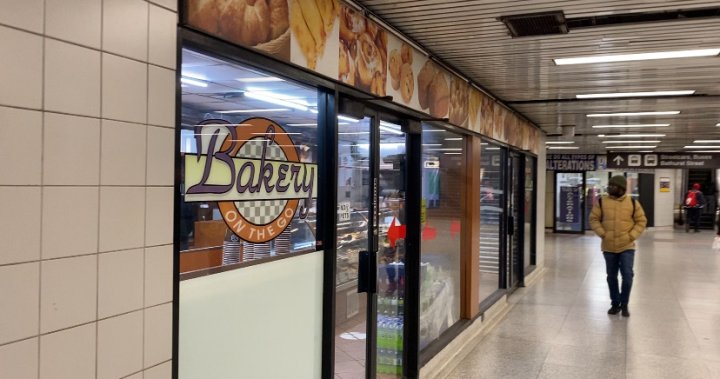Ahmed Abdella has been selling patties from his store inside Bathurst Subway Station for roughly a quarter of a century.
He remembers when crowds of shoppers flocking to now long-gone Honest Ed’s would stop by his storefront, Bakery On The Go, on the way to or from town to grab something to eat.
“We used to get a lot of crowds from the shop,” Abdella told Global News. “And then we were better off because people came with this shopping mind(set).”
Since the pandemic, however, business has been slower. Even four years after businesses were forced to close, Abdella estimates he sees maybe 50 or 60 per cent of the customers who used to come into his shop, with many now working from home.
“The station is quiet, very quiet,” he said. “At this time, before the pandemic, it was very very busy.”
Abdella’s experience is not unique. Across Toronto’s subway network, a collection of underground bakeries, tailors, newsstands and lottery sellers have struggled with lower foot traffic.
The Toronto Transit Commission, which rents the subway station stores, said roughly 30 per cent of its retail locations are currently empty.
Across the subway network, the TTC leases out 79 locations to newstand company Gateway, of which 25 are closed or vacant. Another 41 shops operate as businesses like bakeries or tailors and 12 of those locations are empty.
Having a vacancy rate of roughly one in three stores in 2024 is not what the transit agency had imagined.
Before the pandemic, plans were underway to boost the subway’s non-fare revenue through various measures and work out how to make the most of the retail spots that are passed by hundreds of thousands of passengers every day.
A plan written by TTC staff pre-pandemic suggested that revenue of $5.1 million per year in 2017 should increase to $6.8 million or more by 2024 with the right investments.
“We had a plan in 2018 to try and maximize our non-fare revenue and that included the retail strategy,” Stuart Green, TTC spokesperson, told Global News.
“Unfortunately, then COVID hit and that’s all kind of gone a bit south but we’re ready to revisit that.”
Now-outdated plans had looked to modernize the subway’s retail spaces, with staff finding that shopping culture and presentation at street level were “advancing at a faster pace than the retail on the TTC.”
The subway stores plan was introduced more than 30 years previously, with a series of newsstands set up to sell newspapers, magazines and snacks. The aim was to improve the experience of riding the subway for passengers.
“This mandate continues today,” TTC staff wrote in 2018.
The pandemic poured cold water on that plan to revamp retail, with months of closures and decimated ridership. The number of people riding the Toronto subway cratered and hasn’t fully recovered.
Even at the end of 2023, more than three years after the pandemic was declared and people were told to stay home, ridership is struggling. A recent TTC report found ridership in December 2023 was still 77 per cent of pre-pandemic levels.
“Mostly regulars (come to my store) and most I don’t see them after the pandemic,” Abdella said, describing who normally comes to buy his patties.
The plan to lean into subway retail was dealt a further blow last year, when Gateway and Tobmar, the main tenants for 79 of the subway system’s 120 spaces, ran into financial trouble.
A bankruptcy-related legal procedure began to restructure the businesses, with the TTC being given just $196,000 of $5.3 million it was owed in pandemic rent between April 2020 and 2022.
“The remaining balance of approximately $5.1 million would be written off, noting, however, that $4.4 million of this amount has been recovered through COVID relief funding,” a TTC staff report from early 2023 said.
Struggles for Gateway, its main tenant, and the impact of the pandemic have left the TTC to consider what the future holds.
On the one hand, Toronto is looking at examples of successful models around the world, including the train network in England’s capital city.
“Marks and Spencers have shops all throughout the London Underground, through the train stations in the U.K., because there’s so much traffic,” Green said.
“There’s massive built-in retail customers available.”
On the other hand, Toronto has had a set retail strategy for years and there is a chance it may be difficult to change.
“Retail in the TTC may be the Cinnabon at Eglinton, a couple of Warden Station patty shops, the odd tailor or something,” Green said. “But there may be an opportunity to expand on that, get a longer-term leaseholder in there.”
Massive subway expansion in Toronto offers a potential opportunity to change or increase the number of stores in the centre of Toronto’s transit network.
A three-stop extension into Scarborough is being tunnelled, along with two mainly underground lines along Eglinton Avenue. The Ford government’s signature Ontario Line is also set to open in the 2030s.
A spokesperson for Metrolinx told Global News that future in-station stores would be “determined through the station planning and design process.” The TTC said that the decision would fall to Metrolinx, which is leading station construction.
“As part of our longer-term non-fare revenue strategy, we are looking to get maximum occupancy in the vacant locations,” Green said, adding: “I definitely think it is forward-looking, there will be opportunities.”
Abdella said rent for his store in Bathurst Subway Station is pricey but he has no plans to move his iconic location out of the subway.
“The rent is expensive compared to others, yes, but still it is OK considering the location,” he said. “But now, of course, the business is so slow it is going to be very expensive.”




